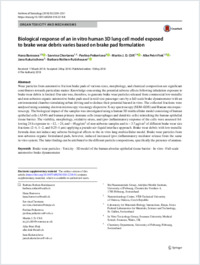Biological response of an in vitro human 3D lung cell model exposed to brake wear debris varies based on brake pad formulation
- Barosova, Hana Bio, Nanomaterials Group, Adolphe Merkle Institute, University of Fribourg, Switzerland - Nanotechnology Centre, Technical University of Ostrava, Czech Republic
- Chortarea, Savvina Bio, Nanomaterials Group, Adolphe Merkle Institute, University of Fribourg, Switzerland - Laboratory for Materials-Biology Interactions, Empa, Swiss Federal Laboratories for Materials, Science and Technology, St. Gallen, Switzerland
- Peikertova, Pavlina Nanotechnology Centre, Technical University of Ostrava, Czech Republic
- Clift, Martin J. D. Bio, Nanomaterials Group, Adolphe Merkle Institute, University of Fribourg, Switzerland - In Vitro Toxicology Group, Swansea University Medical School, Swansea, UK
- Petri-Fink, Alke Bio, Nanomaterials Group, Adolphe Merkle Institute, University of Fribourg, Switzerland - Chemistry Department, University of Fribourg, Switzerland
- Kukutschova, Jana Nanotechnology Centre, Technical University of Ostrava, Czech Republic
- Rothen-Rutishauser, Barbara Bio, Nanomaterials Group, Adolphe Merkle Institute, University of Fribourg, Switzerland
-
01.07.2018
Published in:
- Archives of Toxicology. - 2018, vol. 92, no. 7, p. 2339–2351
English
Wear particles from automotive friction brake pads of various sizes, morphology, and chemical composition are significant contributors towards particulate matter. Knowledge concerning the potential adverse effects following inhalation exposure to brake wear debris is limited. Our aim was, therefore, to generate brake wear particles released from commercial low-metallic and non-asbestos organic automotive brake pads used in mid-size passenger cars by a full-scale brake dynamometer with an environmental chamber simulating urban driving and to deduce their potential hazard in vitro. The collected fractions were analysed using scanning electron microscopy via energy-dispersive X-ray spectroscopy (SEM–EDS) and Raman microspectroscopy. The biological impact of the samples was investigated using a human 3D multicellular model consisting of human epithelial cells (A549) and human primary immune cells (macrophages and dendritic cells) mimicking the human epithelial tissue barrier. The viability, morphology, oxidative stress, and (pro-)inflammatory response of the cells were assessed following 24 h exposure to ~ 12, ~ 24, and ~ 48 µg/cm2 of non- airborne samples and to ~ 3.7 µg/cm2 of different brake wear size fractions (2–4, 1–2, and 0.25–1 µm) applying a pseudo-air–liquid interface approach. Brake wear debris with low-metallic formula does not induce any adverse biological effects to the in vitro lung multicellular model. Brake wear particles from non-asbestos organic formulated pads, however, induced increased (pro-)inflammatory mediator release from the same in vitro system. The latter finding can be attributed to the different particle compositions, specifically the presence of anatase.
- Faculty
- Faculté des sciences et de médecine
- Department
- Département de Chimie
- Language
-
- English
- Classification
- Chemistry
- License
- License undefined
- Identifiers
-
- RERO DOC 322845
- DOI 10.1007/s00204-018-2218-8
- Persistent URL
- https://folia.unifr.ch/unifr/documents/307125
Other files
Statistics
Document views: 66
File downloads:
- fin_brv.pdf: 150
- fin_brv_sm.pdf: 151

